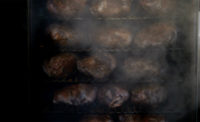Smokehouses are the workhorses of many a meat processing operation. With the production of bacon, jerky, sausages and deli meats, they are constantly in operation. That are a substantial cost for any processor, but given the amount of products they will produce, they will more than pay for themselves by the end of their lifecycle.
Smokehouses, if properly maintained, can have long lifespans. The latest models do come with new technology that can be beneficial to the operator. Gary Bardine of Bardine’s Country Smokehouse, Crabtree, Pa., said that he purchased his smokehouse in 2007 after he was told that the model could heat and smoke in half the time.
“My brother, being an engineer who is into geothermal heating and cooling and energy efficiency, caught up on that right away,” Bardine says. “If you have a product that heats and smokes in half the time, you’re going to cut down on the electricity, you’re going to cut down on the wood chips.”
Dr. Joe Cordray, extension meat specialist at Iowa State University, recommends that processors follow the smokehouse manufacturer maintenance guidelines.
“The inside of the smokehouse should be cleaned on a regular basis. The ductwork associated with the smokehouse should be clean and free of obstructions and should be cleaned on a periodic basis,” he adds. “One of the most common mistakes processors make is not replacing the wet bulb sock on the humidity probe inside the smokehouse. If the wet bulb sock becomes dirty the humidity in the smokehouse will not be properly controlled.
There must also be adequate water flow to the wet bulb sock.
“It is a very good idea to periodically check finished product temperature from each outside edge of the smokehouse rack and the center of the smokehouse rack. If you have more than a few degrees (2 to 3) of temperature difference between the various locations it may be the result of restricted air flow due to improper placement of product on the smokehouse rack or dirty air ducts adversely affecting smokehouse air flow. When taking product temperatures make sure you always check the center of the thickest part of the product. Also make sure you have checked the accuracy of your thermometer,” Dr. Cordray adds.
For processors who use wood chips in their smokehouses, it is important to keep the chips moist so that they don’t burn up too quickly. Bardine says that he knows of several processors who use old mixers to mix chips with water prior to use. Bardine is still using his original mixer, so he came up with a different approach.
“I went to Harbor Freight and bought a cement mixer, and we mix them in there. I always say that consistency is the hallmark of excellence, so when you’re mixing and putting 2 gallons of water with a 50-pound bag of chips, everything is consistent. You’re doing it the same way every time,” he says.
Loading the smokehouse is an important step too, as an overloaded cart can actually lead to decreased quality.
“Racks that are overloaded will restrict air flow in the smokehouse which can result in uneven cooking of the product and poor external color on the product. Product should be evenly spaced on the smokehouse rack so all product has air flow around it to allow for even cooking and uniform external color on the product,” says Dr. Cordray. “If you are cooking a small amount of product, spread it out in the center of the smokehouse rack rather than putting it all on one side of the smokehouse rack or in the corner of the smokehouse rack.”









